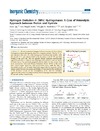Please use this identifier to cite or link to this item:
https://accedacris.ulpgc.es/handle/10553/74724
| Title: | Hydrogen Evolution in [NiFe] Hydrogenases: A Case of Heterolytic Approach between Proton and Hydride | Authors: | Qiu, Siyao Azofra Mesa, Luis Miguel Macfarlane, Douglas R. Sun, Chenghua |
UNESCO Clasification: | 221001 Catálisis | Issue Date: | 2019 | Journal: | Inorganic Chemistry | Abstract: | The mechanism for Hydrogen Evolution Reaction (HER) in [NiFe] hydrogenase enzymes distinguishes them from inorganic catalysts. The first H+/e– pair injected to the active site of the hydrogenases transforms into hydride, while the second H+/e– pair injection leads to the formation of the H–/H+ pair both binding to the active site. The two opposite charged hydrogens heterolytically approach each other in order to form dihydrogen (H2), which is enhanced by the Coulomb force. Two previously proposed reaction routes for this process have been examined by Conceptual Density Functional Theory (DFT) in this work. One presents better agreement with experimental spectra, while the other is thermodynamically more favorable. Both paths suggest that the approach and the charge transfer between the proton and hydride are motivated by the stabilization of the electronic activity and the electrophilicity of Ni. After the heterolytic approach of the proton and hydride moieties, the two hydrogen atoms attach to the Ni ion and combine homolytically. | URI: | https://accedacris.ulpgc.es/handle/10553/74724 | ISSN: | 0020-1669 | DOI: | 10.1021/acs.inorgchem.8b02812 | Source: | Inorganic Chemistry [ISSN 0020-1669], v. 58, 5, p. 2979-2986 |
| Appears in Collections: | Artículos |
Items in accedaCRIS are protected by copyright, with all rights reserved, unless otherwise indicated.
